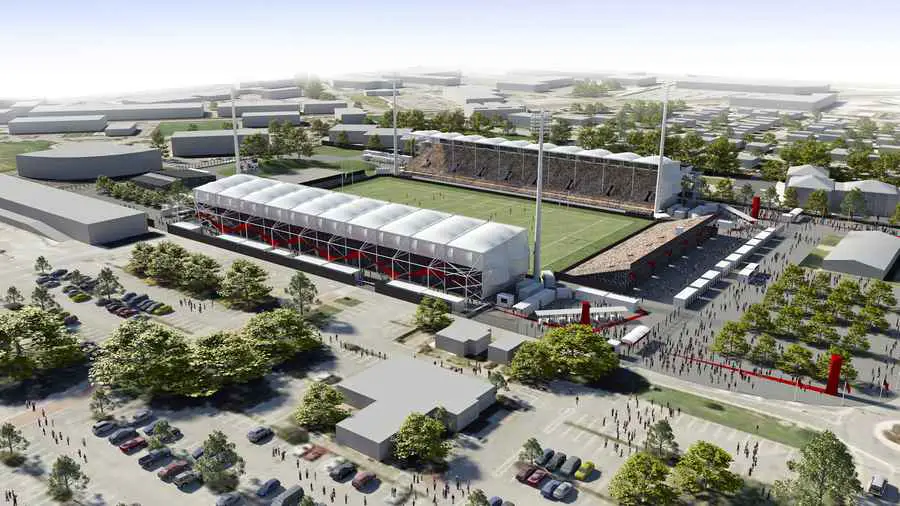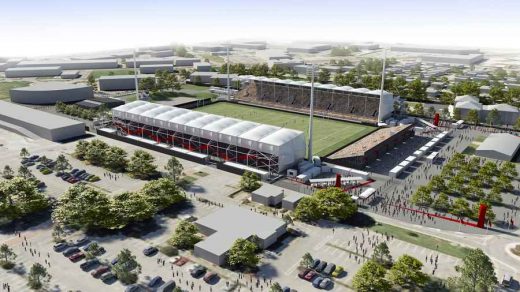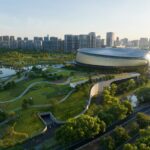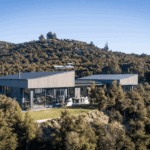Christchurch Rugby Stadium, Addington Building, NZ Sports Venue
Christchurch Stadium : New Zealand Rugby Venue
Sporting Venue New Zealand – design by Populous, architects
3 Mar 2012
Christchurch Stadium Building
Design: Populous
New Zealand Rugby Venue
NEW CHRISTCHURCH STADIUM ON TRACK FOR MARCH OPENING – A SYMBOL OF HOPE FOR A CITY DEVASTATED BY EARTHQUAKE
While Christchurch continues the painstaking process of rebuilding after last year’s destructive earthquake, optimistic signs of renewal are emerging across the infrastructure landscape of the southern New Zealand city.
One such symbol is the new Christchurch Stadium, designed by the global sports specialists Populous. Construction of the temporary stadium, on the site of Rugby League Park in Addington, is on schedule for completion in late March, in time for an early game of the 2012 Super Rugby Season.
The stadium, Canterbury’s only outdoor venue for major sporting and music events, is expected to have a life of between three and five years and stadium architects Populous are using fabric and graphics to embrace its temporary nature and give it a special identity.
Populous, which led the design of both the Eden Park redevelopment in Auckland and the new Forsyth Barr stadium in Dunedin, is drawing on its experience with the London 2012 Olympics, and in particular the main stadium, to help create a unique gathering place in Christchurch.
Populous Project Director, associate principal Daryl Maguire said the stadium is designed and built to the highest safety standards, but fabric and graphics are being used as an imaginative and inexpensive way to “dress” the stadium and create a something special.
“We are working on 35 venues in London for the 2012 Olympics, most involving temporary facilities. We learnt from our work on the new Olympic stadium that clever use of a fabric roof and a stadium wrap (made of strips of boldly coloured material) could help create the drama necessary for such a high-profile Event but was flexible enough to be part of the reconfiguration for a more modest building in legacy mode.
“In Christchurch, we are also using fabric for dramatic effect. A red, lightweight, fabric ribbon – the colour of the famous Rugby Union home team, the Canterbury Crusaders – will be woven through the scaffolding of the temporary stands to draw people in, create a sense of occasion and excitement,” said Mr Maguire.
“This will be a stadium that does not feel “thrown together”, because Christchurch is tired of temporary. This rectangular stadium will have atmosphere, great sightlines, rigorous safety standards and people will be close to the action,” he added.
Sport is important to Cantabrians; they have the most successful rugby union team in the country. But the city’s main sporting and entertainment venue, AMI stadium, was among the buildings so badly damaged in last year’s earthquakes, it was unable to host any World Cup Rugby matches, and its long-term future remains undecided.
The new 18,000 seat Christchurch stadium, with two partially covered stands, will be the only outdoor venue for major sporting fixtures and concerts for the next few years. It will be flexible enough to be used for rugby league, soccer and concerts, and has the potential to increase its capacity to 25,000 for a major event such as a Rugby test match.
New Zealand’s Earthquake Recovery Minister, Hon Gerry Brownlee, inspects construction progress at the stadium regularly, and said Christchurch stadium is an important step towards the restoration of normality to have a venue that catered for first-class sporting matches and entertainment events.
The funding for the temporary stadium will be underwritten by the NZ Government, with support from the Christchurch City Council and New Zealand Rugby Union.
The pitch is a fully drained professional quality field, and the turf has been laid, recycled and harvested from AMI Stadium. Three temporary stands are being built using galvanised steel tubes in a scaffold truss system, replacing two old stands now demolished. The roof will consist of a white opaque fabric made of PVC which is recyclable. Food and beverage facilities will be placed around the perimeter on the four corners of the stadium and the venue will be lit to broadcast standards.
Like the turf, much of the infrastructure is being recycled from other venues. There is temporary seating from Eden Park, where it is no longer required following the Rugby World Cup; stadium lights from Dunedin’s Carisbrook ground; toilet and food outlets from Eden Park.
Corporate boxes are being installed into custom designed, lightweight prefabricated buildings which will be lifted into place at the top of the northern stand. As much as possible, furniture and fittings will also be borrowed from AMI stadium.
This solution gives Christchurch time to properly plan for the long-term future of its sporting facilities.
When the future of AMI stadium is eventually decided, the temporary stadium will also leave behind a valuable legacy in the way of a professional pitch and high quality lighting. The roof can remain in place for the longer term, because it is structurally separate from the stands below, allowing for permanent stands and facilities to be built underneath.
Christchurch Stadium Building images / information from Populous
Location: Addington, Christchurch, New Zealand
New Zealand Architecture
Contemporary New Zealand Buildings
New Zealand Architecture Designs – chronological list
New Zealand Architecture Studios
A recent New Zealand sports stadium design by Populous on e-architect:
Forsyth Barr Stadium, Dunedin
Populous with Jasmax
Forsyth Barr Stadium Dunedin
Christchurch Buildings
Christchurch Rebuilding
The Buchan Group
Christchurch Rebuilding
Christchurch Terminal
HASSELL + Warren and Mahoney
Christchurch Airport
Christchurch Airport Regional Terminal
Christchurch Precinct Master Plan
New Zealand Architecture Awards
Te Mata House, Hawkes Bay, North Island of New Zealand
Stevens Lawson Architects
Hawkes Bay House
Len Lye Centre, New Plymouth
Patterson Associates
Len Lye Centre
Auckland Architecture Awards – NZIA Awards
The Michael Hill Clubhouse, Otago, South Island
Patterson Associates
Southern New Zealand Building
Comments / photos for Christchurch Stadium – New Zealand Sports Venue page welcome






